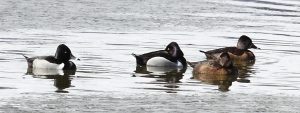
Photo: Kentucky Department Fish And Wildlife
The outlook for the upcoming waterfowl hunting seasons looks as promising as any seasons in recent memory.
“It is shaping up to be a phenomenal year,” said John Brunjes, migratory bird coordinator for the Kentucky Department of Fish and Wildlife Resources. “We are still at all-time highs for duck numbers with as many breeding ducks as we’ve ever had. It’s been that way for a couple of years now.”
Brunjes said biologists conducted duck population counts along the Mississippi River in Illinois last week. They produced four times the normal number of birds counted. “Usually for the second week of November in Illinois, they see about 200,000 birds,” he said. “They counted 800,000 birds along the Mississippi River last week and those birds are heading our way.”
Waterfowl of all stripes are migrating through Kentucky right now. “We are seeing white-fronted geese and even tundra swans in southeast Kentucky,” Brunjes said. “It is very rare. We have a ton of snow geese showing up in weird places this year. The birds are moving well this year.”
The duck, coot, and merganser seasons all open Thanksgiving Day, Nov. 23. The opening segment of the hunting season for ducks, coots and mergansers runs until Nov. 26. These seasons open again Dec. 4, 2017, and close Jan. 28, 2018.
The hunting season for Canada, white-fronted, brant and snow geese also open Thanksgiving Day, but do not close until Feb. 15, 2018.
“We want to remind hunters there is an extended opportunity for geese,” Brunjes said. “The extended season went into effect last year.” Traditionally, goose seasons closed in late January.
A summer devoid of long dry periods set the table for excellent waterfowl habitat this fall. “The moist soil areas and native vegetation look really good,” Brunjes said. “The crops on our wildlife management areas (WMAs) did well. We have the best crops at Ballard WMA that we’ve had in a number of years.”
Finding a place to waterfowl hunt is a challenge for the majority of Kentucky hunters. The first place to check is the public land hunting section of the 2017-2018 Kentucky Hunting Guide for Waterfowl. This section details the hunting options and regulations on public lands, mainly wildlife management areas.
Many, but not all, of the smaller state-owned or managed lakes are open to waterfowl hunting as are reservoirs operated by the U.S. Army Corps of Engineers or the U.S. Forest Service. The bigger waters hold more birds during the coldest stretches of the year, when many farm ponds or smaller lakes freeze over. Call the Kentucky Fish and Wildlife information center at 1-800-858-1549 to inquire if a lake is open to waterfowl hunting.
Those pursuing waterfowl on reservoirs must not hunt near access areas such as boat ramps or areas closed to hunting or public access by signs. Common sense and courtesy dictates waterfowl hunters avoid setting up near private residences or marinas.
Scouting is vitally important to waterfowl hunting success, especially in the first month of the season.
“If you aren’t seeing any birds in the areas you hoped to hunt prior to opening day, you likely won’t see birds on opening weekend either,” Brunjes said. “You have to find the areas birds are using and set up accordingly.”
Waste corn in cut silage fields provides excellent food for ducks and geese. Goose hunters may find agreeable farmers who consider geese a nuisance. Goose hunting in harvested cornfields provides excellent sport and peaks with the coldest weather.
Those farmers may also grant permission to hunt their ponds. From the air, farm ponds dot the Kentucky landscape as craters do the Moon. They can provide the hottest hunting, but not all farm ponds attract birds. Scouting is vital for successful farm pond hunting.
Waterfowl hunters must have a valid Kentucky hunting license, a Kentucky migratory game bird – waterfowl permit along with a Federal Duck Stamp. Federal Duck Stamps are available at post offices across Kentucky.
Waterfowl hunters must have their Harvest Information Program (H.I.P.) confirmation number recorded on either their Kentucky hunting license or on their Kentucky migratory game bird – waterfowl permit. To get your H.I.P. number, visit the Kentucky Fish and Wildlife website at www.fw.ky.gov and click on the “My Profile” tab. Answer a few questions about last season’s harvest of migratory birds to receive your confirmation number. The process takes less than 5 minutes.
“Folks in the neighboring states to our north such as Illinois, where waterfowl seasons are already open, are having great hunting so far,” Brunjes said. “It is early and a lot remains to be seen, but everything is setting up for a great season.”
 Weather
Weather Traffic
Traffic @LouisvilleDispatch
@LouisvilleDispatch @LouisvilleDisp
@LouisvilleDisp Subscribe
Subscribe